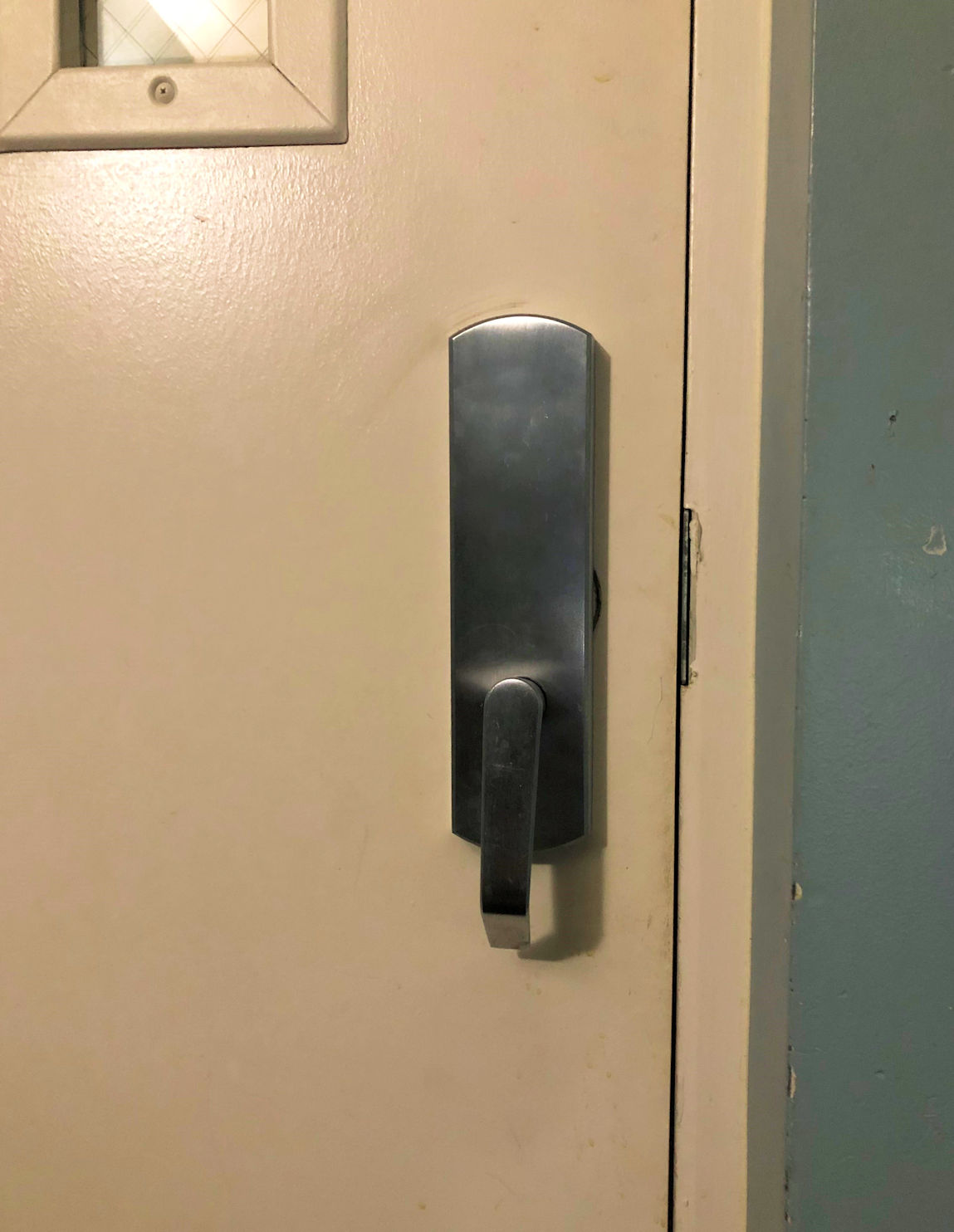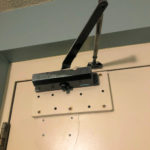 A retired fire marshal asked me a question yesterday about the lever position from one of my recent posts. In the hotel featured in the post, the lever trim for every panic device was in the vertical position. The lever did retract the latch when I turned it 90 degrees…I’m not sure if the lever position was intentional or if it was the result of an installation problem or product failure (it was not an Allegion product, BTW).
A retired fire marshal asked me a question yesterday about the lever position from one of my recent posts. In the hotel featured in the post, the lever trim for every panic device was in the vertical position. The lever did retract the latch when I turned it 90 degrees…I’m not sure if the lever position was intentional or if it was the result of an installation problem or product failure (it was not an Allegion product, BTW).
The fire marshal asked if having the lever in this position created a code issue – whether there was a code requirement or accessibility standard that was being violated. The door could be unlatched with one releasing motion, with one hand, without tight grasping, pinching, or twisting of the wrist. The operable parts were mounted within the allowable range for most US states – 34-48 inches above the floor. BHMA A156.41 – Standard for Door Hardware Single Motion to Egress does not specify in which direction the lever must be rotated, stating: A single operation of less than 90º of rotation shall allow the door to be opened.
One potential problem that I could think of was if a code official thought that the hardware required special knowledge or effort to operate. Hardware used for egress must be operable without a key, tool, special knowledge or effort. With these doors, the vertical lever was on the access side, but building occupants would have to use the lever to leave the stairwell for reentry if the stair became compromised during a fire.
So my question for you is this: Have you seen lever handles purposely mounted in the vertical position? If you are an AHJ, do you have concerns about this application?
WWYD?
You need to login or register to bookmark/favorite this content.









Is that how the manufacturers’ instructions allow them to be installed?
Hi Curtis –
I doubt that the instructions show this, but somehow they were working.
– Lori
I have seen that before and the idea was to prevent someone from reaching underneath the door with an “Under the Door Tool” and opening from the inside.
https://lockpicktools.com/under-the-door-tool/
That makes sense! I think when I was asked about this before it was related to a college that wanted to install their dorm room levers vertically for this reason.
– Lori
I have seen several mounted this way. They also mount cage locks this way- straight up and down. If I’m not mistaken, they also do it in other countries. I personally don’t like it. It is way easier to use gravity and the weight of your arm to help push the lever down.
I agree, Tim. It’s easier to push the lever down. But if it operates with the allowable force (5 pounds or 28 inch-pounds depending on which standard is used), that shouldn’t be a code issue.
– Lori
DHI Convention in San Francisco, 1999 or 2000, Grand Hyatt Hotel:
Levers on the guest rooms were drooping at a 45° angle. Third day in, it occurred to me that it was to prevent under door attacks.
Couple years later, Ft. Lauderdale, Florida, Holiday Inn Express:
Levers were vertical, wow, keep your wallet in your front pocket! By the next morning 7 pizza ads had been slid under the door.
Interesting! I don’t remember seeing this application on a hotel room yet.
– Lori
I think that even though there is no specification defining lever position, commonalty still will play with the mind of the AHJ, which it should. Each area of jurisdiction have the right to apply a standard ruling based on the community that is based on common knowledge shared by the community.
I agree – it’s just easier if the codes are prescriptive so we don’t have to rely on AHJ opinions.
– Lori
I just did a talk on the history of this a few months ago.
Chains of hotels bought a certain lock bypass tools for all the hotels in their lines. It was meant to solve the problem when they upgraded locks to new fancy ones without key override.
For years lock companies had sold cylinders with a hotel function and they controlled these keys and just like masters. The new locks did not have these and like all stand alone locks after a few years batteries died.
But unlike a key the bypass tools were not controlled and less reputable staff did bad things with them. Staff that never had a master had access to this tool.
The 45 deg vs the 90 deg is just a matter of the hub. Many of the locks have a star hub making it easy to put them at 45 deg.
I see it in the same light as the barrier devices as they just did not buy the correct lock. They bought the hype and then had a problem. Colleges and Universities are / were next.
Thanks for sharing your insight, John!
– Lori
I have been thinking about this since you first posted it. In my opinion, this would not be acceptable as it requires special knowledge. If I see a door lever hanging down like this, it immediately think it is broken. In an emergency, I may not even try the door since it looks abnormal.
Yes, I can imagine some AHJs share your opinion on that, although the lever position is not specifically called out in the codes.
– Lori